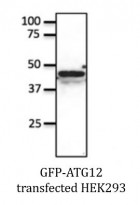ARG42494
anti-ATG12 antibody
anti-ATG12 antibody for ICC/IF,IHC-Formalin fixed sections,IHC-Frozen sections,Western blot and Dog,Human,Monkey,Mouse,Rat
Overview
| Product Description | Goat Polyclonal antibody recognizes ATG12 |
|---|---|
| Tested Reactivity | Hu, Ms, Rat, Dog, Mk |
| Tested Application | ICC/IF, IHC-F, IHC-Fr, WB |
| Host | Goat |
| Clonality | Polyclonal |
| Isotype | IgG |
| Target Name | ATG12 |
| Antigen Species | Human |
| Immunogen | Purified recombinant peptide within aa.65 to the N-terminus of Human ATG12. |
| Conjugation | Un-conjugated |
| Alternate Names | Ubiquitin-like protein ATG12; FBR93; HAPG12; APG12-like; Autophagy-related protein 12; APG12L; APG12 |
Application Instructions
| Application Suggestion |
|
||||||||||
|---|---|---|---|---|---|---|---|---|---|---|---|
| Application Note | * The dilutions indicate recommended starting dilutions and the optimal dilutions or concentrations should be determined by the scientist. |
Properties
| Form | Liquid |
|---|---|
| Purification | Affinity purification with immunogen. |
| Buffer | PBS, 0.05% Sodium azide and 20% Glycerol. |
| Preservative | 0.05% Sodium azide |
| Stabilizer | 20% Glycerol |
| Concentration | 3 mg/ml |
| Storage Instruction | For continuous use, store undiluted antibody at 2-8°C for up to a week. For long-term storage, aliquot and store at -20°C. Storage in frost free freezers is not recommended. Avoid repeated freeze/thaw cycles. Suggest spin the vial prior to opening. The antibody solution should be gently mixed before use. |
| Note | For laboratory research only, not for drug, diagnostic or other use. |
Bioinformation
| Database Links | |
|---|---|
| Gene Symbol | ATG12 |
| Gene Full Name | autophagy related 12 |
| Background | Autophagy is a process of bulk protein degradation in which cytoplasmic components, including organelles, are enclosed in double-membrane structures called autophagosomes and delivered to lysosomes or vacuoles for degradation. ATG12 is the human homolog of a yeast protein involved in autophagy (Mizushima et al., 1998 [PubMed 9852036]).[supplied by OMIM, Mar 2008] |
| Function | Ubiquitin-like protein involved in autophagy vesicles formation. Conjugation with ATG5 through a ubiquitin-like conjugating system involving also ATG7 as an E1-like activating enzyme and ATG10 as an E2-like conjugating enzyme, is essential for its function. The ATG12-ATG5 conjugate acts as an E3-like enzyme which is required for lipidation of ATG8 family proteins and their association to the vesicle membranes. (Microbial infection) May act as a proviral factor. In association with ATG5, negatively regulates the innate antiviral immune response by impairing the type I IFN production pathway upon vesicular stomatitis virus (VSV) infection (PubMed:17709747). Required for the translation of incoming hepatitis C virus (HCV) RNA and, thereby, for the initiation of HCV replication, but not required once infection is established (PubMed:19666601). [UniProt] |
| Cellular Localization | Cytoplasm. Preautophagosomal structure membrane; Peripheral membrane protein. Note=TECPR1 recruits the ATG12-ATG5 conjugate to the autolysosomal membrane. [UniProt] |
| Calculated MW | 15 kDa |
| PTM | Acetylated by EP300. [UniProt] |
Images (4) Click the Picture to Zoom In
-
ARG42494 anti-ATG12 antibody IHC-P image
Immunohistochemistry: Human pancreas stained with ARG42494 anti-ATG12 antibody at 1:500 dilution.
-
ARG42494 anti-ATG12 antibody ICC/IF image
Immunofluorescence: Hepa1-6 cells were fixed with methanol. Cells were stained with ARG42494 anti-ATG12 antibody (green) at 1:50 dilution. Nuclear staining (blue).
-
ARG42494 anti-ATG12 antibody WB image
Western blot: GFP-ATG12 transfected HEK293 cells. 100 µg of cell lysate stained with ARG42494 anti-ATG12 antibody at 1:500 dilution.
-
ARG42494 anti-ATG12 antibody IHC-P image
Immunohistochemistry: Mouse kidney stained with ARG42494 anti-ATG12 antibody at 1:500 dilution.







